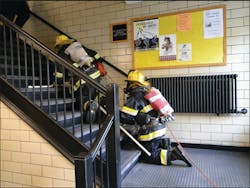In August 2010, Worcester Polytechnic Institute (WPI) in Massachusetts, with support from the U.S. Department of Homeland Security (DHS) Science and Technology (S&T) Directorate and Federal Emergency Management Agency (FEMA), hosted the fifth annual technology workshop on "Precision Indoor Personnel Location and Tracking for First Responders." As in past years, this workshop provided a forum for researchers and developers working in the important area of indoor location and tracking of emergency response personnel to share technical knowledge and to define the state of the art.
The focus of this workshop was zero pre-installed infrastructure tracking; that is, systems that do not require any previously installed wiring or equipment in the target building. Further, the focus was on systems that provide complete tracking and position information on all equipped personnel to the incident command post.
This workshop resulted from WPI's research effort to develop a location and tracking system that started as a result of the tragic fire in Worcester in 1999 in which six firefighters lost their lives in a cold storage warehouse fire, just a few city blocks from WPI, as a result of getting lost and disoriented. A search team of two firefighters became lost in the labyrinthine structure, as did two successive rescue teams. The technology to provide exit guidance or to locate a firefighter in trouble - ropes and personal alert safety system (PASS) devices - was inadequate in such circumstances as the Worcester warehouse fire. This motivated researchers at WPI and elsewhere to apply modern technology to solve this important problem.
To ensure the quality of the workshop from the perspective of both presentations and audience participation during the focus group and plenary sessions, attendance is subject to a proposal and review process. More than 140 people were accepted to attend the workshop and the interest was so great a waiting list had to be created. The attendees included researchers and developers from academia and industry, government representatives and members of the fire service. The agenda consisted of a unique mix of presentations, demonstrations and exhibits, posters, keynote presentations, working sessions and system demonstrations by the Worcester Fire Department (WFD). The poster session was a new addition this year and was required to accommodate all the attendees wanting to report on their excellent progress made over the last year.
The workshop started with a powerful session titled "Fireground Injury and Death: Not Everyone Goes Home!" given by Chief Billy Goldfeder. He provided case studies analyzing tragic fire deaths and their impact on their families and colleagues. Follow-on sessions provided presentations on Government and User Perspectives, Inertial and Integrated Navigation Systems, and RF and Other Technologies. For the first time, presentations and posters featured the use of location and robotics for first responder applications. This year, National Institute of Standards and Technology (NIST) representatives hosted a new session investigating standards development for the new technology of location and tracking systems that were starting to move from laboratory prototypes to commercial systems. These types of systems are more complex than existing electronics carried by firefighters and it is anticipated that new standards and procedures will be required before they can be deployed.
Three keynote speakers provided their agencies' perspective on indoor location and tracking: Jalal Mapar, program manager, DHS Science and Technology Directorate; Dr. Nancy Merritt, senior policy advisor for the National Institute of Justice (NIJ), the research and development branch of the U.S. Department of Justice; and Dr. Stefanie Tompkins, program manager, Strategic Technology Office, Defense Advanced Research Projects Agency (DARPA).
As part of the workshop, Mapar sponsored a user focus group that discussed various issues identified by the user community and to provide feedback to the system developers. This focus group was chaired by Deputy Fire Chief Mark Amatrudo of the Wilton, CT, Fire Department. The focus group discussion centered on what had been learned at this year's workshop. The group agreed on the following main summary points:
- The standards process is now being considered
- Vendors don't realize that procedural differences exist among departments (operational prospective)
- There may be legal ramifications of decisions based on Physiological Status Monitoring (PSM) data on the scene
- There is no silver bullet solution (combination approach
- Limited money from federal organizations is being provided, which is slowing progress to solve the problem
- It is time to relook at requirements and prioritize them
- A broad-based public safety users group should be formed
- The tracking system needs to operate in the background
The final session consisted of the demonstration of three systems. The WFD conducted a simulated search and rescue mission in a large building on the WPI campus using each system. The actual demonstrations took place earlier that day and were recorded by cameras at the command site and a camera that followed the firefighters. During the final session, the audience viewed a picture-in-picture replay of the three demos while the incident commander, Deputy Chief John Sullivan of the WFD, described the action. This session was well received by the attendees as it provided a unique opportunity to see how well technology has improved over the last year by providing a realistic environment to evaluate the systems.
The three systems were:
- Heuristic Navigation for Tracking in GPS Denied Areas (Kent Garland, NAVISEER product manager, SEER Technology Inc.)
- Near-Field Electromagnetic Ranging (NFER) Technology for Emergency Responder (Dr. Hans Schantz, chief technical officer, Q-Track Corp.)
- Personal Dead-Reckoning (PDR) System for Firefighters (Johann Borenstein, research professor, Mechanical Engineering Department, University of Michigan)
The workshop organizers are extremely grateful to the developers of the three systems for volunteering to take part in this exercise and to Deputy Chief Sullivan for organizing the scenario and providing the many firefighters needed (using a fresh team for each of the system demonstrations). This evaluation provides a chance for everyone at the workshop to assess the present state of the art and to provide valuable feedback to all developers for the areas that still need improvement.
The simulated search and rescue mission assumed that a firefighter had become lost and incapacitated when evacuation was necessary during a primary search at the scene of a fire. The building used for the exercise was a large (24,000 square feet), four-story building on the WPI campus. The scenario assumed the last known location of the lost firefighter was somewhere on the top floor and this was the information provided to the rapid intervention team (RIT).
Prior to the workshop, the WFD conducted the same exercise, but in this case the members of the RIT had no location technology to guide them; instead, they used classical search techniques to search the floors and rooms by hand to find the lost firefighter (who was placed in a room on the third floor of the building). The time to find the "lost" firefighter was 24 minutes, requiring two RITs for this baseline.
During the workshop, three fresh crews repeated the exercise, but this time each crew used one of the three location and tracking technology systems and the information they provided, to guide the RIT directly to the location of the firefighter. In previous workshops, or similar exercises, the use of technology has actually slowed the time to complete the search and rescue, since in many cases, the technology provided erroneous information and sent the RIT to the wrong floor or room. In many cases, the scenario even had to be abandoned since it was obvious that the system was never going to guide the rescuers to the lost firefighter. However, this year we are pleased to report that all three systems successfully allowed the RIT to locate the firefighter and in all cases faster than the unaided baseline result.
This exercise was, of course, only one test, and it should not indicate that these systems are necessarily ready for deployment, but the results are very encouraging and indicate that we are finally getting closer to a working location and tracking system for first responders.
DR. R. JAMES DUCKWORTH is an associate professor in the Electrical and Computer Engineering Department at Worcester Polytechnic Institute (WPI). He is the principal investigator for the WPI Precision Personnel Locator (PPL) system and has been working on the project for the past six years. His main research and teaching focus is on the design of location and tracking systems and embedded computer systems. He has authored or co-authored over 50 technical papers and presentations, has published a book on digital logic design, and has two patents. Dr Duckworth is a Senior Member of the IEEE, a member of ION and IEE, and a Fellow of BCS.
About the Author

Dr. R. Duckworth
For Firehouse.Com
DR. R. JAMES DUCKWORTH is an associate professor in the Electrical and Computer Engineering Department at Worcester Polytechnic Institute (WPI). He is the principal investigator for the WPI Precision Personnel Locator (PPL) system and has been working on the project for the past six years. His main research and teaching focus is on the design of location and tracking systems and embedded computer systems. He has authored or co-authored over 50 technical papers and presentations, has published a book on digital logic design, and has two patents. Dr Duckworth is a Senior Member of the IEEE, a member of ION and IEE, and a Fellow of BCS.
